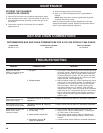
12
UK
ADJUSTING IDLING SPEED
See Figure 24.
■■
■■
■ If the engine starts, runs, and accelerates but will not idle,
turn the idling speed screw “T” clockwise to increase
idling speed.
■■
■■
■ If the chain turns at idle, turn the idling speed screw “T”
anticlockwise to reduce the idle RPM and stop the chain
movement. If the saw chain still moves at idling speed,
contact a Ryobi service dealer for adjustment and
discontinue use until the repair is made.
WARNING:
THE SAW CHAIN SHOULD NEVER TURN AT IDLE. Turn
the idling speed screw “T” anticlockwise to reduce the idle
RPM and stop the chain, or contact a Ryobi service dealer
for adjustment and discontinue use until the repair is
made.
Serious personal injury may result from the saw chain
turning at idle.
OPERATING THE CHAIN BRAKE
See Figures 25 and 26.
Refer to “Safety” earlier in this manual for additional information.
Check the operating condition of the chain brake prior to
each use.
1. Start the engine and grasp the front and rear handles
securely with both hands.
2. Pull the throttle trigger to bring the chainsaw up to full speed.
Using the back of your left hand, engage the chain brake (A)
by pushing the chain brake lever/hand guard toward the bar
while the chain is rotating rapidly.
See Figure 25.
NOTE: The chain brake should engage and stop the chain
immediately. If not, stop the saw by placing the ignition switch
in the “O” stop position. Take the saw to a Ryobi service
dealer for repair and discontinue use until the repair is made.
3. Reset the chain brake back into the RUN position (B) by
grasping the right-hand side (from operator’s position) of the
chain brake lever/hand guard and pull toward the front
handle until you hear a click.
See Figure 26.
FELLING TREES - HAZARDOUS
CONDITIONS
See Figure 27.
WARNING:
Do not fell trees during periods of high wind or heavy
precipitation. Wait until the hazardous weather has ended.
When felling a tree, it is important that you heed the following
warnings to prevent possible serious injury.
■■
■■
■ Wear eye, hearing, and head protection (A) when operating
this equipment.
■■
■■
■ Do not cut down trees having an extreme lean or large trees
with rotten or dead limbs, loose bark, or hollow trunks. Have
these trees pushed or dragged down with heavy equipment,
then cut them up.
■■
■■
■ Consider the distribution and weight of heavy limbs (B).
■■
■■
■ Clear out the undergrowth around the tree to be felled (C).
■■
■■
■ Do not cut trees near electrical wires or buildings (D).
■■
■■
■ Consider the direction in which the tree leans (E).
■■
■■
■ Check the tree for damaged or dead branches that could
fall and hit you during felling (F).
■■
■■
■ Periodically glance at the top of the tree during the
back-cut to assure the tree is going to fall in the
desired direction.
■■
■■
■ Keep all bystanders at a safe distance (G) (at least twice the
height of the tree).
■■
■■
■ Prepare a path of safe retreat (H).
■■
■■
■ If the tree starts to fall in the wrong direction, or if the saw
gets caught or hung up during the fall, leave the saw and
save yourself!
■■
■■
■ Consider the wind direction before felling a tree.
■■
■■
■ Do not fell trees near power lines or near buildings which
could be struck by falling limbs or the tree itself.
■ The chainsaw operator should keep on the uphill side of the
terrain as the tree is likely to roll or slide downhill after it
is felled.
■ Remove dirt, stones, loose bark, nails, staples, and wire
from the tree where felling cuts are to be made.
WARNING:
Do NOT fell trees near power lines or near buildings
which could be struck by falling limbs or the tree itself.
PROPER PROCEDURE FOR TREE FELLING
See Figure 28 through 31.
1. Pick your escape route (or routes in case the intended
route is blocked). Clear the immediate area around the
tree and make sure there are no obstructions in your
planned path of retreat. Clear the path of safe retreat
approximately 135° from the planned line of fall (A).
2. Consider the force and direction of the wind, the lean and
balance of the tree, and the location of large limbs. These
things influence the direction in which the tree will fall.
Do not try to fell a tree along a line different from its
natural line of fall (B).
3. Cut a notch about 1/3 the diameter of the trunk in the side of
the tree (C). Make the notch cuts so they intersect at right
angles to the line of fall. This notch should be cleaned out to
leave a straight line. To keep the weight of the wood off the
saw, always make the lower cut of the notch before the
upper cut.
4. Make the back-cut (D) level and horizontal, and at a
minimum of 2 inches (5 cm) above the horizontal cut of
the notch.
NOTE: Never cut through to the notch. Always leave a band
of wood between the notch and back cut (approximately
2 inches (5 cm) or 1/10 the diameter of the tree). This is
called a “hinge” or “hingewood” (E). It controls the fall of the
tree and prevents slipping or twisting or shoot-back of the
tree off the stump.
OPERATION


















